Sometimes a term is used improperly with such lamentable frequency that it worms its way into the lexicon of accepted speech. Texting, doping, ROTFL, and LOL are some common offenders. So it is also with the ambiguous moniker Assault Weapon. Nobody can ascertain with certainty a precise definition beyond that its very existence seems to unsettle the less durable members of society. However this nebulous term might be applied, the Assault Weapon as a concept is not unique to the Information Age.
In the 1870’s the nation still reeled from the recent Civil War that had very nearly ripped it asunder. Emotional wounds were still raw, and the frontier beckoned the disenfranchised, adventurer, and malcontent alike to an exciting new life in an untamed world bereft of rules. In such a rugged land the possession of a proper firearm frequently spelled the difference between freedom and enslavement, wealth and destitution, or even life and death. With so much riding on the details, the flower of American engineering prowess strived to produce the optimized hunting and defensive tools. The legendary Oliver Winchester proffered his eponymous firearm to the masses via the magical combination of reliable performance and shrewd marketing. His Model of 1873 had a veritable pantheon of parents.

Oliver Winchester touted his Model 1873 as “The Gun That Won the West.” Graceful, reliable, and accurate, the 1873 Winchester was a high-capacity repeater that fired a potent centerfire cartridge.
Origin Story
The lever action 1873 could trace its origins back to the Volcanic repeating rifle birthed in 1855 by Daniel Wesson and Horace Smith. The Volcanic repeater was as much a cartridge as a rifle and in that respect was really too much too fast. Those early self-contained Volcanic cartridges were caseless after a fashion sporting an exposed powder charge in the base of a conical bullet. While the materials science of the day could not produce a reliable caseless round that could withstand the rigors of foul weather and rough handling, the subsequent generation was much more promising.
With economic failure a certainty, Oliver Winchester, a clothing magnate, bought out the interests of both Smith and Wesson and reorganized the failing Volcanic company in his own image. The resulting New Haven Repeating Arms Company employed one Benjamin Tyler Henry as its chief foreman. By 1860 Mr. Henry had improved upon the Volcanic mechanism and married it to the then-revolutionary .44 rimfire metallic cartridge. While this fortuitous relationship was indeed an improvement, there yet remained a catalyst of some sort required to make the radical and expensive design truly successful. That catalyst came in the form of the American Civil War. It’s always preferable to be lucky than good. In the case of Oliver Winchester, he enjoyed both attributes in comparable measure.
More than 14,000 Henry rifles saw service during the war. Southerners facing these remarkable weapons in action came to respect their prodigious firepower when compared to the muzzle-loading muskets of the day. In 1866, right after the war ended, the Henry rifle got an upgrade in the form of a side-loading gate, wooden fore-end, and sealed tubular magazine. Nelson King designed these features and his name is roll marked on the barrel of my vintage Winchester rifle. The model of 1866 was the first model to formally take on the name Winchester. The 1866 Winchester sported a two-pronged firing pin that struck these early rimfire rounds in two places for more reliable ignition. 170,000 of these 1866 rifles rolled off the lines before production halted in 1898.
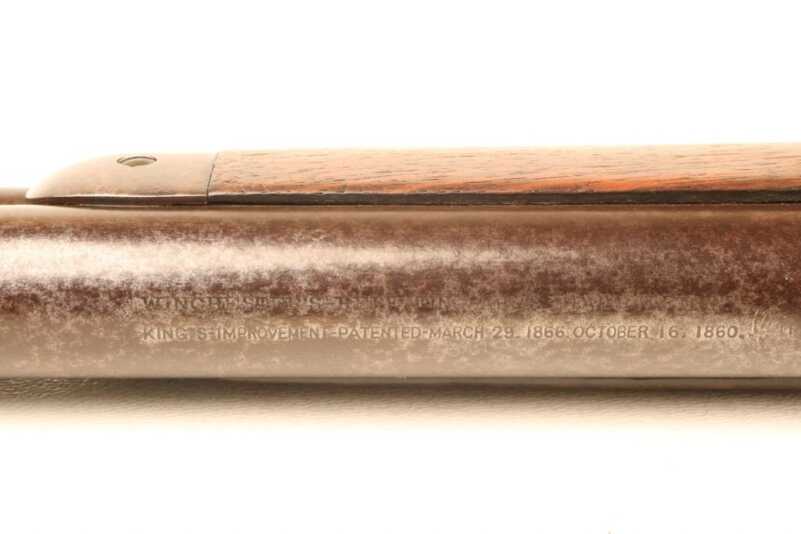
Nelson King’s name is included in the roll mark on the barrel as “King’s Improve-ment” listed before the patent dates.
In 1873 the improved Winchester action met the centerfire metallic cartridge, and that’s when the real magic blossomed. In the 1873 rifle rugged individualists finally found a gun that was accurate, reliable, and weatherproof. These early rifles were chambered for the .44-40 Winchester round. Other terms used for the same cartridge were .44 Winchester Centerfire and .44 WCF. Later versions fired the .32-20 and .38-40. Winchester could not chamber his rifles for the .45 Long Colt round as Colt held the patent on that particular cartridge. Regardless, in the .44 WCF the frontiersman had a rifle that could theoretically fire the same round as his handgun.
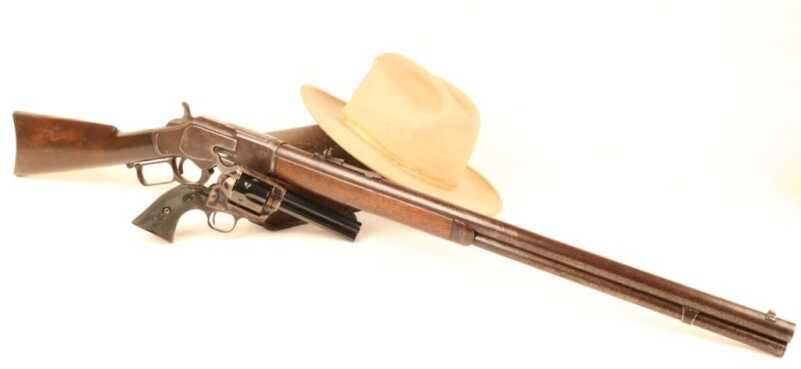
One of the appeals of the 1873 Winchester was that it could conceivably fire the same round as a man’s handgun. Ammunition commonality made logistics easier on the frontier.
Winchester was a master marketer, and he contrived a variety of angles to separate Americans from their hard-earned cash. Not unlike today, gun nerds simply had to have the best, fastest, coolest smoke pole on the market. In the process, he made a literal killing. When his fortune went to his widow after his unexpected death in 1880 she became one of the wealthiest women on the planet.
Morphology and Variations
The 1873 Winchester sported a steel receiver along with proper metallurgy in its barrel that allowed the gun to handle the relatively high performance of the .44 WCF round. Various barrel lengths and contours, engraved variations, and rifle, carbine, and musket versions kept things spicy. By announcing that the very best barrels were incorporated into special edition versions Winchester sold his one-of-one hundred and one-of-one thousand rifles. There were eventually eight of the former and one hundred thirty-six of the latter. Possession of one of these guns today is the functional monetary equivalent of a generous trust fund.

Oliver Winchester touted his Model 1873 as “The Gun That Won the West.” Grace-ful, reliable, and accurate, the 1873 Winchester was a high-capacity repeater that fired a potent centerfire cartridge.
More than 720,000 1873 Winchesters were produced, and the last original copy left the factory in 1923. One-of-one thousand rifles sold for a cool $100 in 1875, the modern-day equivalent of about $2,200. Eventually, John Moses Browning got involved and improved the design yet again into the model 1894, but that is a story for another day.

There is a pivoting lock on the bottom of the tang that will hold the action closed manually if need be.
Italian replicas of the 1873 Winchester enjoy unflagging esteem today thanks in large part to the popularity of Cowboy Action Shooting. Modern versions are also produced in a number of variations in Japan and then sold under the original Winchester banner. A 2018 SHOT Show special of the venerable Winchester gun was the Model 1873 Deluxe Sporting rifle. Chambered for .38 SPL/.357 Magnum, this modern reproduction sports a 24-inch barrel and an MSRP of $1,799.
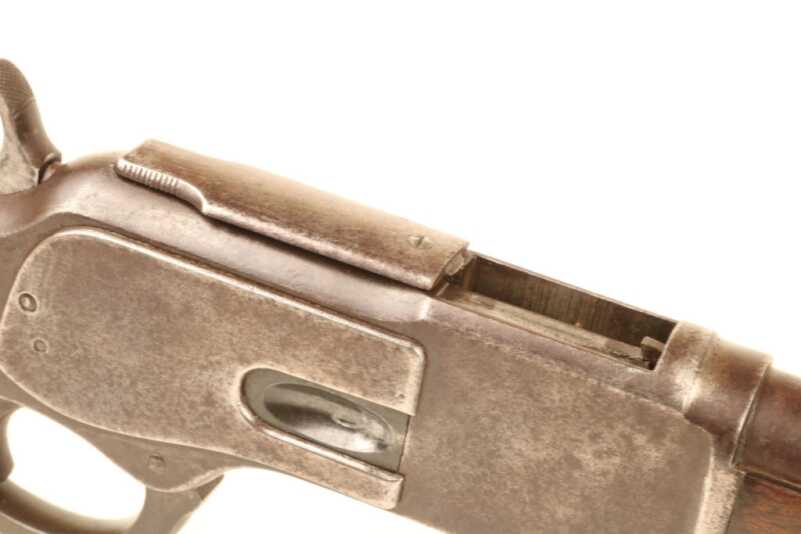
The top-mounted sliding dust cover retracts automatically when the action is cycled. Nelson King added the side-loading gate to the original Henry repeater and made it markedly more efficient.
Handheld History
My 1873 Winchester was produced in 1891 and was a barn find of sorts. A friend’s dad found the gun in an abandoned house, and he sold it to me at a fair price when he needed tires for his truck. The rifle has seen its share of action yet remains mechanically sound. It is simply gorgeous to behold.
There is a rotating lock that secures the lever action in the closed position, and the rifle indeed loads via a spring-loaded gate on the right side of the receiver. The sliding top-mounted dust cover opens automatically when the action is worked. A bronze lifter feeds the rounds into position for chambering and helps eject the empties while lending the rifle a fascinating mechanical elegance. The external hammer cocks of its own accord but can be manually lowered to render the gun safe. There is no manual safety.
The rear sight is ramp adjustable and the forward version secures via dovetail. The buttplate sports a deep crescent that secures the gun in firing position as though it was in a vise. There is a buttstock trap for accouterments. The aged walnut sports that inimitable feel and hue so characteristic of that enchanted material and contrasts nicely with the gun’s worn patina. Working the action manually today produces the same glass-smooth cycle that so impressed cowboys back in the 1870’s. This process on my gun has been made velvety by literally countless repetitions.
Denouement
Oliver Winchester touted the 1873 Winchester as “The Gun That Won the West.” As the victors write the history, that claim fits tidily within our sanitized frontier narrative. Civilization is objectively preferable to chaos, so in that vein such conquest was inevitable.

The 1873 Winchester was the AR15 of its day. Popular, potent, and powerful, this lever action wonder gave its wielder a decided advantage in armed combat.
In reality, the 1873 was the AR15 of its day. Wielded by hard men on both sides of the law as well as determined homesteaders facing daunting odds, Oliver’s revolutionary rifle was indeed a splendid equalizer. Then as now, a man with a gun was a citizen, while a man unarmed was either a victim or food. Whether the threat was untamed savages, shifty ne’er-do-wells, or carnivorous fauna, the 1873 Winchester protected home and hearth while ably keeping the cooking pot filled. In so doing it was the embodiment of the 19th century concept of the Assault Weapon.
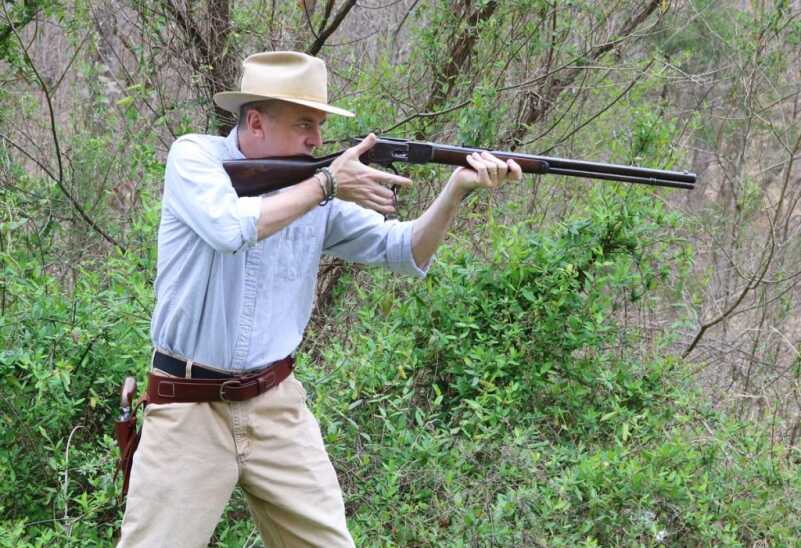
The Winchester 1873 revolutionized armed combat. Light-years ahead of its contemporary competition, the Model 1873 was the Assault Weapon of its day.
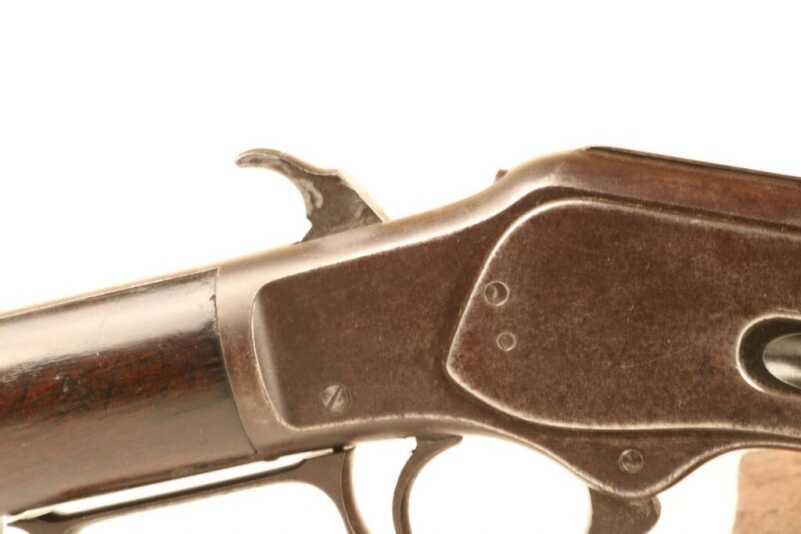
The 1873 Winchester has no manual safety. There clearly weren’t so many lawyers back then. To safe the gun you carefully lower the hammer manually.
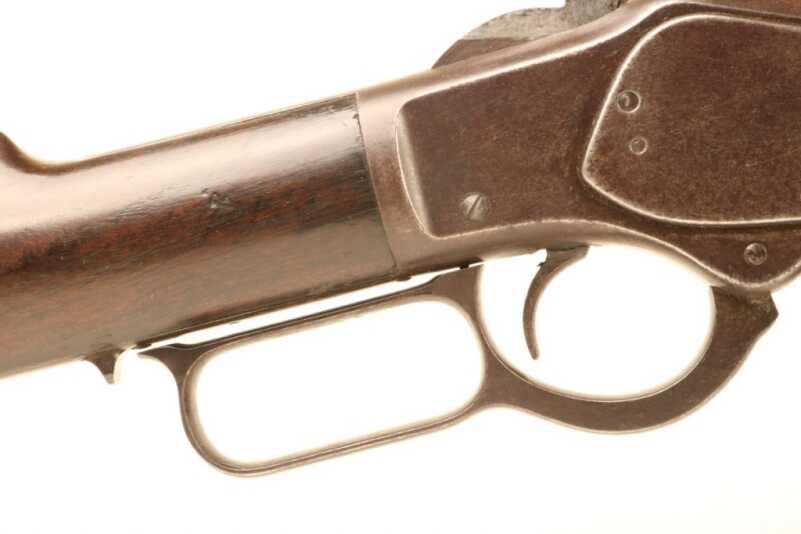
There is a pivoting lock on the bottom of the tang that will hold the action closed manually if need be.

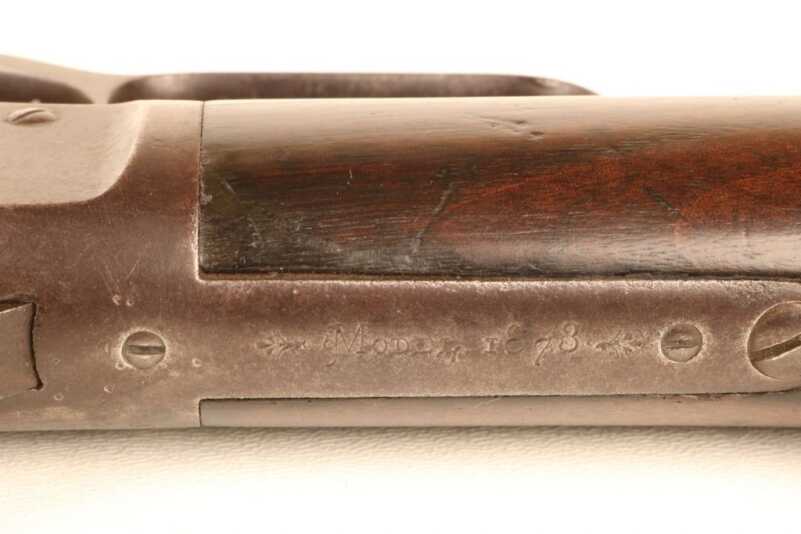
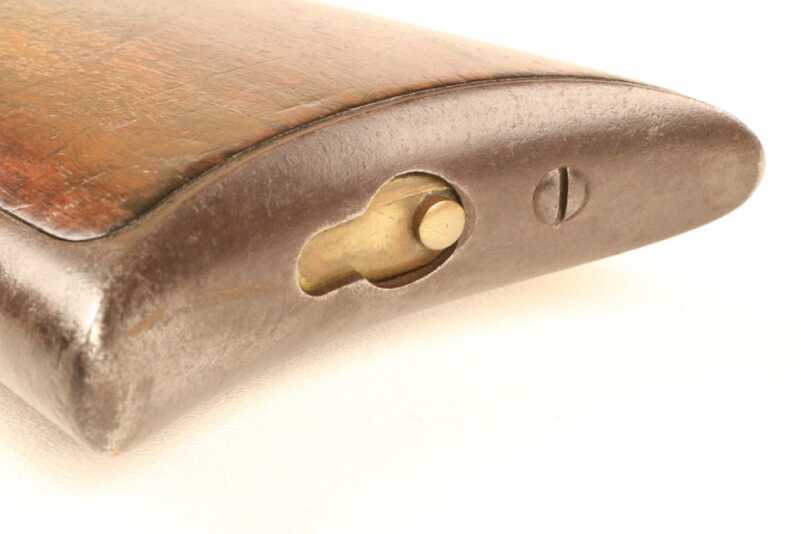


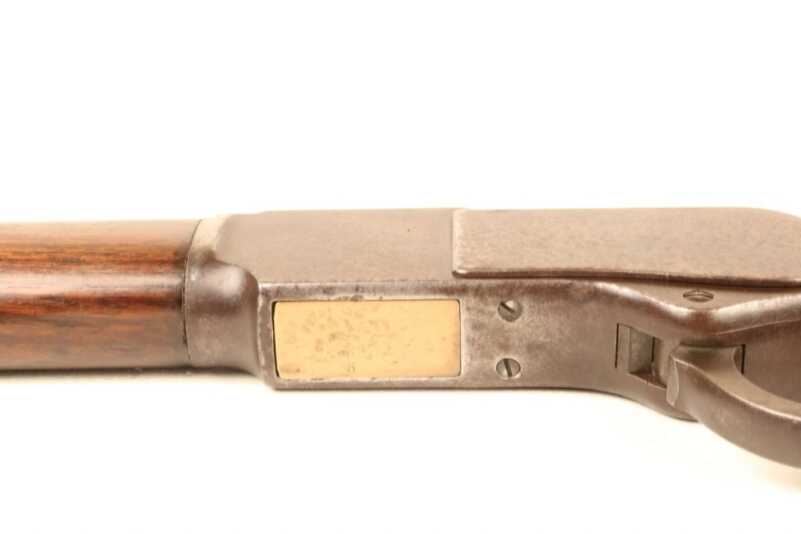
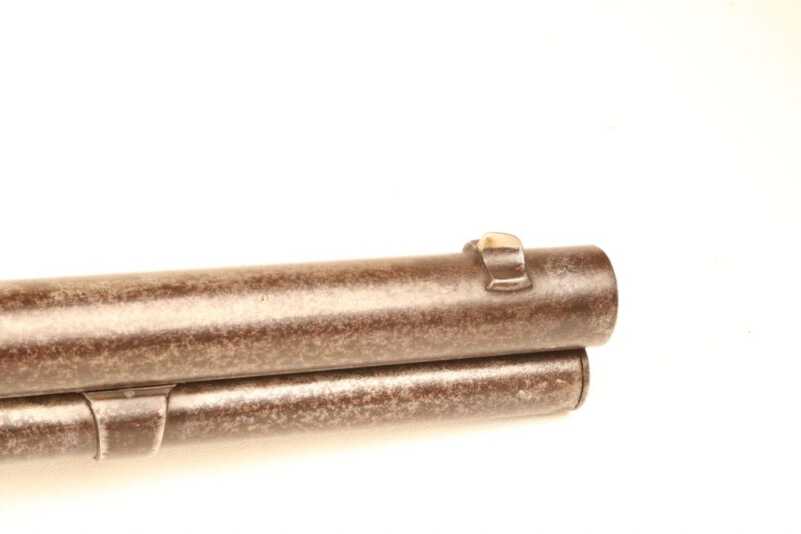

I thought that honour was bestowed to the Girandoni air rifle (https://en.wikipedia.org/wiki/Girandoni_air_rifle). Silent and a 19 round magazine makes it not only impressive but illegal in some US states. Not bad for 1780 tech. And effective enough to keep Lewis and Clark with their scalps.
John Browning’s relationship started much earlier than 1894. He designed the very strong action for the 1886 rifle, which was designed to fire full power rifle cartridges, unlike the pistol cartridge only 1873, and in addition was capable of handling full length cartridges, unlike the 1876 Centennial rifle.
The 1886, which features a two lug locking device, was down-sized for pistol cartridges with the 1892. The 1892 Winchester is still being produced under license by FN/ Miroku (Japan), and Rossi makes a clone.
For all here that are cringing at the use of “assault” in connection with this rifle, or even the AR called out, I am also cringing. Just what constitutes an assault weapon? In my mind it has always been a weapon capable of firing a cartridge with a full selectable trigger. Guess I am way off. The model 1873 may have been the AR equivalent of its day, however I do not think of the AR as an assault weapon either. So, while I do appreciate the good review and the history lesson, thank Mr. Dabbs, I think we really must be cautious with the “assault weapon” terminology. As so many others have pointed out here, the left anti 2A activists will surely be all over this claiming even such antiquated and historic rifles should be confiscated and destroyed. After all, the Pro 2A folks even call them “assault weapons.”
Did anybody pay attention to the post of Jake.. his statement of a full battle rifle cartridge,with less than full power qualifies as asualt ammo. That means that anything other than full power, is an assault ammunition. That means, anything that digest it is an assault weapon. ATF has always called an assault weapon a mechanism that supplied selected fire. I Now I understand that it is a sub battle rifle caliber that is subject to there whims. Jake and I are correct, I live in California thanks for your attention peace on America!!!
The 69 cal Brown Bess flintlock rifle was America’s true assault rifle. With it our forefathers were able to fire 3 shots per minute and win our liberty.
The Brown Bess was not a rifle, it was a musket. I think the rifled flintlocks of the time, made in Pennsylvania and Kentucky had more of an impact on the outcome of the revolutionary war.
Rifles in the hands of American forces during the American War of Independence played only a minor role; there were never enough to make a difference.
Bear in mind that the 1770s were well before the Industrial Revolution; interchangeable parts did not exist (the first US issue small arm to achieve interchangeability was the Model 1842 Percussion Musket, 69 caliber). Each “firelock” (inclusive term for individual shoulder arm at the time) was unique to itself. Rifles were more expensive; they had to have grooves cut into the bore, a labor-intensive process in that day. Since each bore size was different, a custom-made bullet mould had to be supplied with each arm. More expense. Troops armed with rifles brought their own.
Rifles of that day did not mount a bayonet, and took three to four times longer to load than a musket. This meant riflemen were helpless after giving fire and had to be protected by detachments of musket-armed light infantry. Unit tactics were built around massed firepower at very short range: 100 yds or less. Entire units lined up in two or sometimes three ranks and fired at the enemy’s ranks. Minimum loading speed was four rounds per minute.
Contrary to popular opinion, the “Brown Bess” (British Second Model Land Pattern musket) played a steadily shrinking role during the war. The French sold more than 100,000 obsolete muskets to the Americans, through deals arranged by Benjamin Franklin and Silas Deane. This was done surreptitiously through blind transactions and dummy firms until France entered the war in 1778, but by mid 1777 there were many in US hands and the piece played a major role in the battles near Saratoga (known today as Schuylerville) in September & October of 1777.
The used French firelocks had been made at the state arsenals of Charleville and Maubeuge and were of several models. But the commonest was the Model 1763 marked “Charleville” and that is how the piece is generically known today.
Contrary to popular legend, General George Washington knew US forces were barely effective because of lack of uniformity of drill & movement; and the untrained, unblooded Americans became notorious for breaking and running when British units advanced with bayonets fixed. The fledgling United States accepted an offer from Friedrich Wilhelm Ludolf Gerhard Augustin von Steuben, a Prussian officer who had served on the staff of Frederick the Great, to standardize drill and tactics, and train troops – which he did at Valley Forge beginning in February 1778. “Baron von Steuben” was a fake; he’d never risen above the rank of captain. The Americans neither knew nor cared, because he was not at all fake in his abilities and got results. By that summer, General Washington commanded “an army who could look the enemy in the face.” Britishers who met the Continentals in action were shocked.
The French pattern of firelock – dual-neck hammer, barrel bands instead of pins, 69 cal – impressed the Americans so much that they copied it when Springfield and Harpers Ferry began producing arms. The design changed only in minor ways until the 58 cal Rifle-Musket was introduced in 1855. Thousands were in storage and were modified with a percussion lock – the largest and most obvious alteration.
The Brown Bess was actually .75 cal, firing an undersized .69 caliber patched ball. This configuration allowed for faster reloading and lessened the impact of fouling.
. Assault? If I was to assault someone with a baseball bat how would you define the weapon? I believe the word Assault is really the issue here. This term assault when used with a firearm should state, this person was assaulted with an AR 15, Shotgun,pistol etc.Certainly not assault weapon because an AR 15 is not, nor is any other firearm use by the general public.
1873 was a most productive year as both the model 1873 Winchester and the 1873 Colt Single Action Army revolver were first produced and offered for sale to the Military and the public. They both were of superior design and function as well as beautiful and pleasing in appearance. They were so very good that the British bought them and used them in Africa for harvesting meat and for protection. I have a Second model 1873 that went to great Britain and passed their proof and hardness tests as noted by the proof stamps on the barrel and receiver, It was made in 1880 and is in remarkable condition. I’m at the age where it is prudent to sell off all my cherished guns and find them new homes where they will be appreciated and cared for as I have. A few of my guns appear in the WINCHESTER BOOK by George Madis.
I got it .it was a slight bit of sarcasm. Good article.
Oh, oh, one or more of California’s anti-Second Amendment democrats will pick up on the ‘assault rifle’ moniker being tied to the Winchester 1873 by a firearms expert. Next move is to enact legislation that heavily regulates the lever action. The anti-gunners will most likely limit magazine capacity to five rounds, require micro stamping, try to alter evil features.
I am only joking..I hope.
Whether it was a little bit of sarcasm or not, the gun control cartel just loves it when we identify any firearm as an assault weapon. To them it is an admission on our part that assault weapons are a thing. We have got to be careful of the terminology we use because I would be willing to bet that here in CA and elsewhere serfs are supplying their masters with the information in this article to be used as a means of eliminating another class of firearms.
Either joking or not Deerfield Il. has banned just about every semi- auto rifle known, and next will be lever and bolt. With a $1,000 a day fine.
I’m a cowboy shooter and LOVE my Uberti 1873. It’s just as beautiful as it is functional and accurate. I was floored the first time I took it apart to see how intricate it was inside considering it was designed in the mid-late 1800s without the use of a computer aided design. Way to go Winchester and company!
The man that wrote this piece must have had his brain in his pocket. The Model 73 nor the AR15 are not even close to being ASSAULT weapons. If you were ever in the military then you would know what an assault weapon is. You are playing into the hands of the GUN GRABBERS that want to ban a gun that can shoot a few rounds without being reloaded. I have more to say but possibly some one else would like to elaborate on your article.
Take a chill pill, Bob. It’s called tongue-in-cheek, perhaps you’ve heard of it?
try re-reading the first paragraph, for heavens sake!
As to your remarks, do you really believe they need any help?!?
They are who they are, and they would ban a peashooter if they could get away with it.
They don’t even look for anyone “playing” into their hands, it wouldn’t change a thing.
The 1st was a ROCK!
This is the best written GunsAmerica article to date. Many would say that your rifle is a perfect candidate for a Turnbull restoration but I think it is perfect just as it is.
Agreed. Dr. Dabbs prose makes for good firearms education.
Nice review and a great old rifle. I do have to take exception to the use of the term ‘assault weapon’. In todays turbulent times the term is used in so many negative connotations making use of it makes it sound evil. I can lay my hand on a womans breast, does that make it a ‘sexual assault weapon’ and it should be banned?
Very “smart” to associate the lever gun with assault weapons. Those who don’t know guns probably would not have made the connection. Now anti-gunners have a new target. Congrats and thanks for the “support”.
What side are you on?
On the contrary. It is a good article for that comparison for people to argue that our founding fathers had every intention to have the people’s militias to be armed with weapons that any military had.
Muskets at one time. Lever actions Semi autos Full autos. I’d say we’re slacking for NOT following the 2a to the letter of their true intent.
You must remember, it was dictatorships the citizens were worried about.
I have to disagree with the article and comments on the article using the term Assault Rifle”. The leaver action rifle in it’s first reliable form was certainly “Born in Battle” during the civil war with the Henry. The leaver action firearm has never been adopted by any country as a standard arm. Some countries have used a few as fill in and certainty not as an assault rifle under any definition. Anyone ignorant of the definition of an assault rifle to include the ’73 in the group should not be writing gun a articles. The loyal opposition will now include a long list of leaver action firearms on the forbidden firearms. Sometimes you need to think first (write articles) later.
Like the article , luv the rifle. … But please STOP, .. S-T-O-P, .. using the term “assault weapon, assault rifle, assault whatever” !!!! It was one of the first SEMI-automatic rifles. We have enough problems with “2A” hating politicians without firearm magazines & writers giving them ……. more ammunition to use against “2A”.
“Enchanted material”- what a lovely term to apply to old walnut. I’ve spent untold hours removing the various plastic varathanes and urethanes applied to newer walnuts, then sanding and staining and oiling them attempting to approximate that “inimitable feel and hue…. of that enchanted material” with only limited success. It appears that that enchantment can only develope with the passage of time.
Enjoyed the reading and agrees with the writer. My great, great grandfather was Mr. Bass Reeves, and he certainly relied by the gun indicating that it saved his life on my occasions. I would not be here as an individual if it was not for this gun. Thanks Winchester.
I really wish everyone in the gun community would stop using the word “ASSAULT WEAPON”!
Anything can be an assault weapon, why do you choose to use the language of the left?
“Assualt Rifle” is a Media fabrication to drive an anti-gun policy of the liberal left. Any firearm, knife, club, bow/arrow and human body parts can used in an Assult. I think the Winchester Model 73 is a great example of using the word “Assualt”to show the rifle flexibility and capability. I honor and respect the history of the 73 and it’s ability defend or Assualt with repeated fire depending on a human need.
Using the term “Assualt” is a media anti-gun preference, why not call it a “Defence Rifle” it is superb for that use.
Another lie is the spray of shots. The Armalite Rifle #15 and most clones are light, accurate to 300 yards and the light recoiling making almost any size person a good shooter. Assualt Rifle is a lie, ASSUALT HUMAN is the TRUTH.
Assault Weapon is a made up term. Terms like Assault Rifle and Main Battle Rifle are not. I personally like the term Modern Sporting Rifle. The Armalites were developed from sporting rifles Eugene Stoner made for he and his wife. Modern Sporting Rifle (MSR) also reflects the reality that so many rifles, now to include even bolt guns, are modular and share components and stocks, grips and many other things with the AR’s.
The German MP-44 was demonstrated for Hitler. He exclaimed that this was a “sturmgewher” which translates as assault rifle. From there forward the assault rifle has been defined as a magazine fed, selective fire rifle, chambered in a medium power cartridge.
A selective fire rifle chambered in a full power cartridge such as the M-14, FN FAL, or G3 is a Main Battle Rifle. The rest is made up by the media searching for something that sounds horrifying to all the snowflakes.
Great article, thank you.
The article was very good. But I didn’t like the analogy with “assault rifle”….unless you sarcastically or ignorantly are playing into the narrative lingo. The history of the the repeating rifle style had (of course) in its original intent as being a weapon of war like the AR configuration. However, as the repeating lever action rifle morphed into a hunting and defensive firearm so has the AR platform. Therefore I would argue…as it could be argued for a “Brown Bess/Kentucky Long Rifle”, that the history of many a long rifle has had its day in combat and then went to the hunting field, can be self defense and sport shooting with the “assault” portion only in the history.
Weapon of war would certainly be correct for the 1873 and the AR15 morphed [into] a military rifle. Not the other way around.
As Civilians owned them before the military adapted them.
“…Civilians owned them before the military adapted them.” [shrugger, April 9 20188:30 AM]
This is untrue.
What is commonly called “AR-15” today was a redesign of ArmaLite’s AR-10, which fired 7.62×51 NATO but appeared to late to compete in the test & trials that ended with the selection of the M14 as an officially issued US long arm in 1957.
There was wide disagreement at the time within the US Army, about just what the next issue arm should be. US Army Ordnance had insisted NATO go with a “full power” cartridge; hence 7.62×51 was selected instead of a smaller, lighter round with reduced power. Not every faction greed – many wanted to copy what the Germans had down and what the Soviets were doing. The debut of 222 Remington (a commercial venture by Remington) in 1950 had occasioned much notice, and the Army started up a program it called “Small Caliber High Velocity” to investigate potential in the 222, which fired a 50gr bullet to something like 3140 ft/sec.
ArmaLite found out, and put together a team to downsize the AR-10 to fire 222. Initial trials of this AR-15, as they named it, were promising, including field trials in Southeast Asia, where US special ops advisors were already at work. Users were impressed; the Army required further development and a new, slightly longer cartridge was made, which became 223 Remington years later.
The US Air Force contracted with Colt’s, to make some 20,000 rifles to replace the M2 Carbines that the Army was taking away (USAF did not want to bother with the large, heavy, powerful M14 for security use). The Army refused to allow the Air Force purchase to go through, claiming they had overall authority form small arms. But more Army experts were now interested, and requested more AR-15s be sent to Southeast Asia. After yet more development and changes, the M16A1 was adopted.
Colt’s had licensed production rights and the trade name “AR-15” from ArmaLite, which was an engineering development organization with no production facilities of its own. They commenced production and supplied US DoD needs for the select-fire military version for many years. Somewhat later in the 1960s, the developed a semi-only clone which used the trademarked name “AR-15,” but sales were very slow: by 1974 production had only reached 35,000.
So “AR-15” got used twice: first by ArmaLite, then by Colt’s, for two different items.
This is a GUN blog. We know what the author was trying to convey. Kinda sardonic in your tone, OK?
VERY GOOD REVIEW THANKS. IF I HAD THE MONEY I WOULD LIKE ONE. VERNON NRA MEMBER.